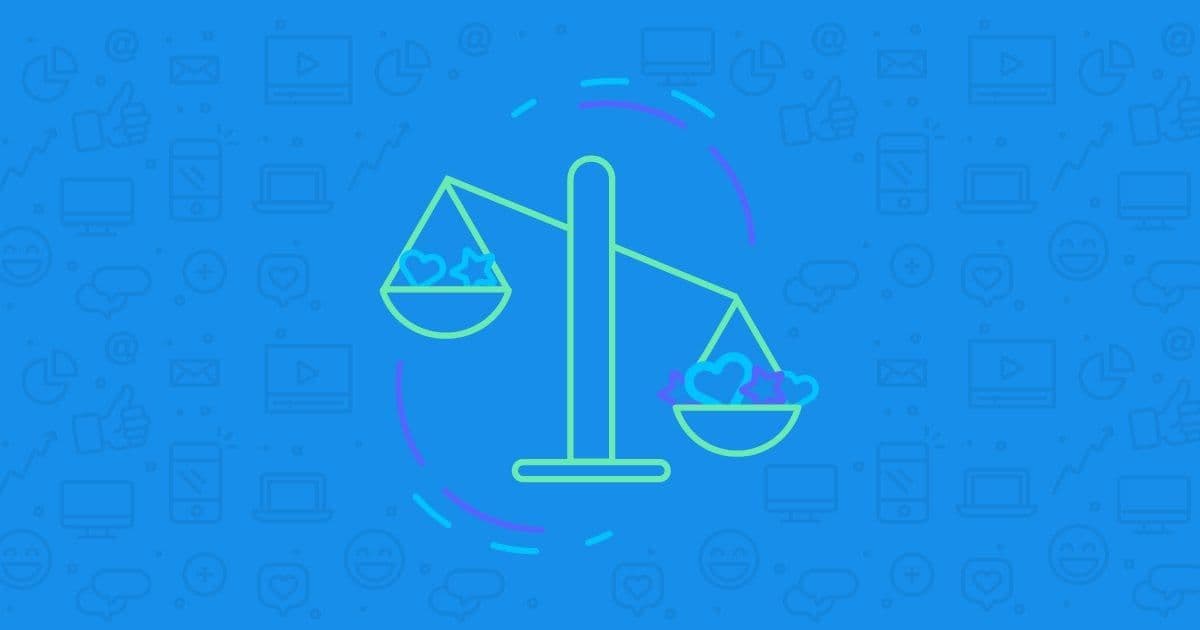Do you have big goals you’d like to achieve in 2017?
We do, too. In fact, this is our vision for Q1:
Establish Buffer as the premier social media tool for businesses and teams via a focus on branding, content, and community.
That sounds pretty broad, right? And how can social media help us to achieve that vision?
The answer is goal-setting.
The great thing about social media is that you can achieve so many different types of incredible results. From acquiring new customers to using social as a customer service channel, the possibilities are endless. But with so much possibility, it can also be hard to stay on track and laser-focused if you don’t have solid, well-defined goals in place.
Read on to see exactly how we set and measure social media goals here at Buffer. I hope this helps in your 2017 planning and maybe even provides a little inspiration.
Let’s do this!
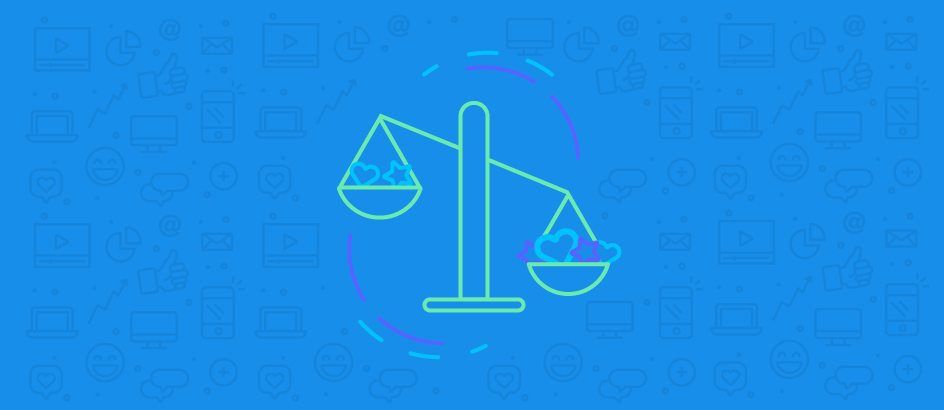
Our top 5 social media goals
Here at Buffer, we use a combination of goal-setting strategies and techniques, along with OKRs to define our goals for each quarter. Here are our top 5 social media goals right now (in order of importance):
- Grow brand awareness around Buffer
- Build Buffer’s community
- Drive traffic to our blog and generate leads
- Establish Buffer as a social media and marketing thought-leader
- Use social media as a product and idea launch pad
In certain campaigns, we might be focusing on only one or two of these goals, while in other campaigns, three or four of them might be a top focus.
For example, we might create a video for Facebook on Instagram marketing techniques with the main goal of reaching a target audience of small-to-medium sized agency owners (brand awareness), but this campaign would also serve under the thought leadership goal.
A win-win!
Let’s take a look at what each of these social media goals means and how we go about measuring our success.
1. Grow brand awareness around Buffer
Brand awareness is one of those concepts that is a bit tricky to fully define and measure. But it’s a critical part of getting potential customers into your social media sales funnel.
What is brand awareness?
Definitions vary from business to business based on marketing goals, but essentially, brand awareness is the likelihood that potential (ideal) customers have heard of or are familiar with your brand.
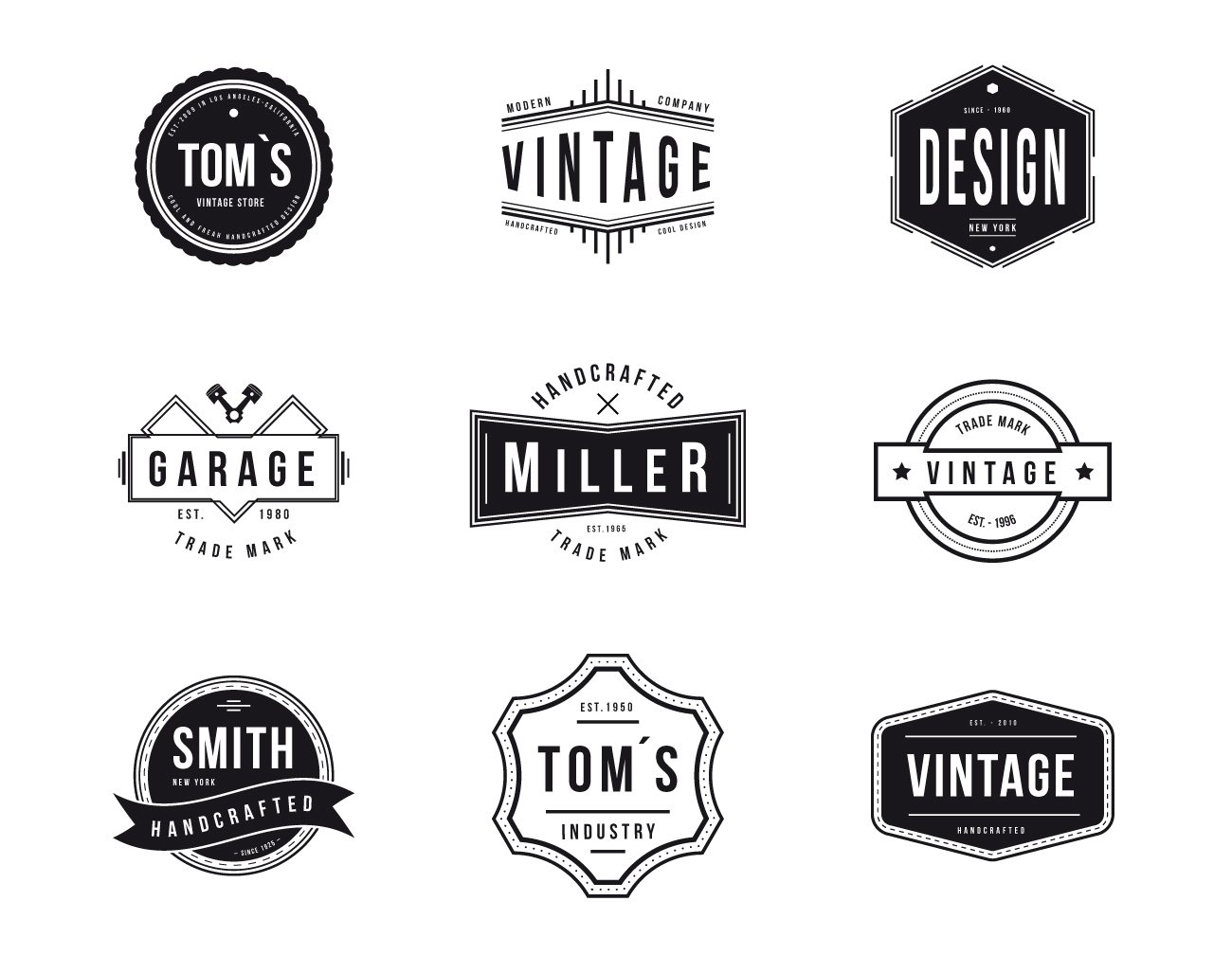
(Could potential customers identify your logo right away?)
Brand awareness tends to sit at the top of the funnel as its main purpose is to build familiarity with as many people as possible.
When we think about brand awareness in relation to social media at Buffer, the main goal is to create content that reaches as many people as possible – and do that consistently. This is a top goal because the more people we have in the TOFU (top-of-the-funnel) the more opportunities we have to deliver valuable content in the hopes that they give Buffer a try.
Examples of top-of-the-funnel content could include:
- Blog posts
- Videos
- Facebook Ads
- Podcasts
- Guest posts
- AMAs
This often requires experimenting with new content types. For us, this has meant creating video content, trying out new social platforms, launching a podcast, and more.
Once we’ve built awareness through our TOFU content, the ideas is that people will move through our funnel:

For example:
- Awareness: Could be watching a video of ours on Facebook
- Interest: Could be following us on Twitter
- Engagement: Could be ‘Liking’ one of our Facebook posts
- Action: Could be joining our email list or signing up to Buffer
- Advocacy: Could be sharing one of our blog posts with a friend or colleague
By reaching as many people as possible at the awareness stage, we hope to continually keep new leads progressing through our funnel.
How we measure brand awareness on social media
Brand awareness is one of my favorite social media goals to measure because I can directly relate it back to total numbers. Here’s are some of the main metrics I measure:
- Total Impressions
- Total Reach (Organic and Paid)
- Total Engagement (Likes, comments, shares)
- Audience size
- 10-second video views
- Podcast episode downloads
Using a combination of Buffer Analytics reports and in-app metrics, I am able to quickly identify how our social media content is performing in terms of our brand awareness goals.
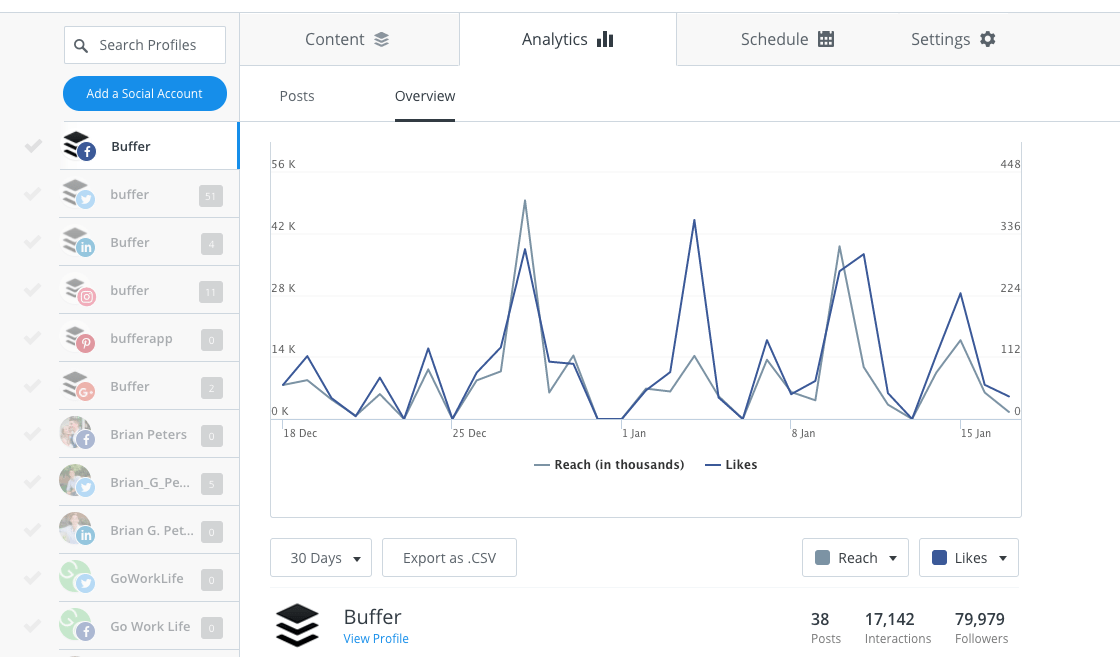
(A look at the graph section of our Buffer Facebook Analytics dashboard)
The key part is setting social media goals that are both ambitious and time-sensitive based on previous results.
For example, in Q1 of 2017, I have set a Total Engagement goal of 1,000,000 interactions with our posts across social (Likes, comments, shares). This is because in the quarters leading up to Q1 of 2017, I have identified that 1,000,000 would be a 10% increase in interactions – a lofty goal.
Engagement level is a great sign of the overall health and quality of both blog and social media content. If we increase engagement numbers by 10% in Q1, that means that we’ve not only added folks to our social sphere, but that they’ve also enjoyed our content (and maybe even shared it with their friends!)
2. Build Buffer’s community
Today, social media dominates consumer attention to the point that nearly 20% of all time spent online in the US across both mobile and desktop is on social media.
In 2017, the chances are your potential customers are on social media, they’re interacting with brands, chiming in on important conversations, and looking for the next big thing to be a part of – that’s where you come in!
What is community building?
Community building is the process of engaging, interacting, and proactively making audience members in your social media sphere a part of your brand’s story.
This can take the form of many different marketing activities, but at Buffer we implement a community building strategy on social media through things like:
- Customer service focused social channels
- User-generated content on Instagram
- Buffer Slack Community Groups
- #BufferChat on Twitter every Wednesdays
- Asking questions in our social posts
- Instagram and Snapchat takeovers
- Facebook Live Friday broadcasts
- Social media giveaways
- and more!
Here’s a recent Facebook Live session where audience members could ask me anything about Snapchat Spectacles.
And an example of one of our recent social media giveaways on the Buffer Instagram:
This small Buffer Swag giveaway generated 58% more engagement on a single photo compared to our average. These engagements turned into opportunities to have one-on-one conversations with customers (the engagement part of our funnel I mentioned a little earlier).
How we measure community building success
A lot of the community building metrics that we keep a close eye on are based on the total number conversations we’re having in addition to growth and health of those conversations.
For example, we handle the majority of our customer service on social media through our own Buffer product – Respond. Respond allows us to handle customer inquiries on Twitter and Facebook and provides us with a ton data on our community building and response efforts.
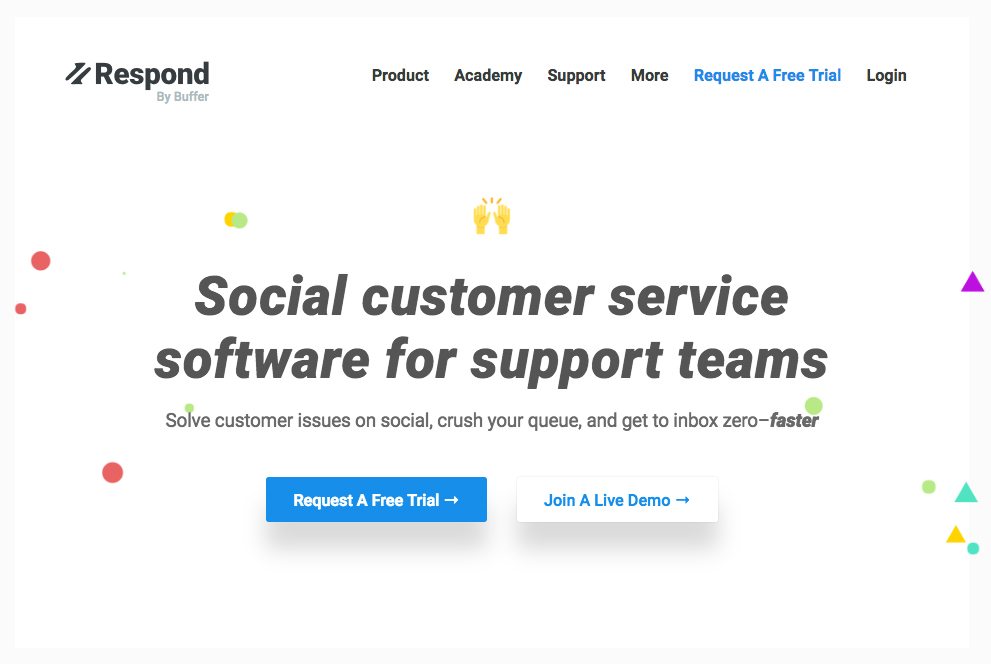
Our customer service goal for Q1 is to respond to every single customer inquiry on social media within a 48-hour time period with a total message volume of greater than 3,000 per week and within a 24-hour time period with a total message volume of less than 3,000 per week.
Our #BufferChat goals for Q1 are to reach an average of 50 new participants each week and increase the number of page views we receive to our #BufferChat recaps within the first 7 days.
We arrived at these growth numbers based on previous data and ambitions to be a leader in both this space. Breaking up our community building social media goals into several specific action items allows us to closely track our efforts and quickly make the necessary changes week-over-week.
3. Drive traffic to our blog and generate leads
The social media traffic to our blog has declined steadily over the past few years. In fact, this time last year (despite a 50% drop in social media traffic in 2015), we were still generating nearly 120,000 unique visits per month to our blog from social media alone.
Today, social media drives around 45,000 unique visits per month – down another 62.5% from Q1 2016.
From my point of view, though, 45,000 unique monthly visitors is still no small figure (and part of me refuses to give up on traffic!)
Plus, the data on our blog’s importance in overall user growth is hard to ignore.
Why traffic generation?
Our Social Blog converts traffic to trial users by a whopping 2-3% (even higher on some articles). If I can increase the overall traffic from social by even 10-20% overall (45,000 to 55,000) that could result in an extra 90-180 customers per month.
Those 90-180 customers might then become Awesome Plan users and eventually, when they’re ready, a Buffer for Business user. As we begin to understand our funnel even further, we can play with those numbers and attempt to increase our efficiency and build off of our social media goals.
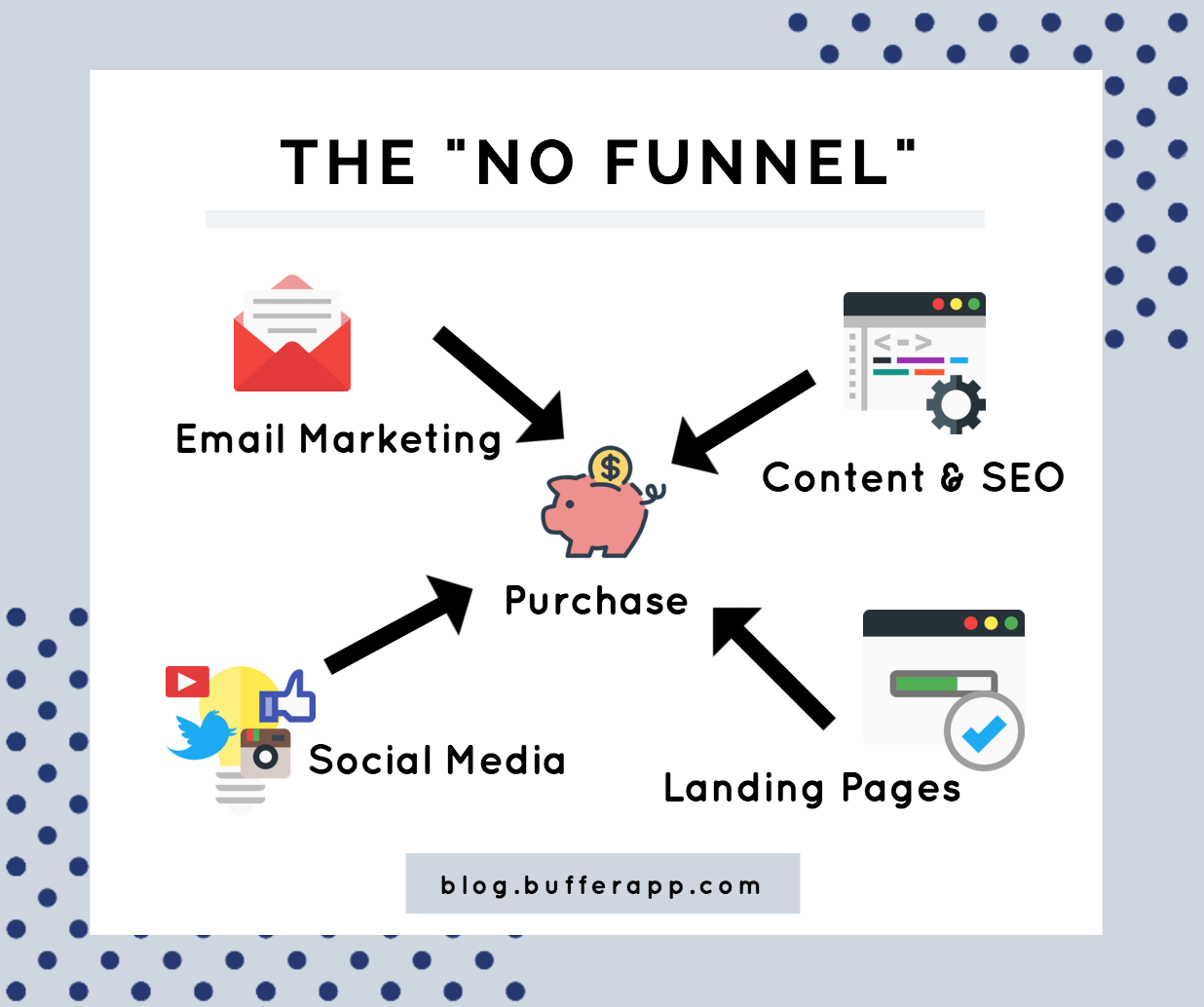
(Often times users don’t follow a traditional marketing funnel – Ex., blog to customer)
Blog content also fuels our social media channels and gives us the opportunity to repurpose the content in fun ways across each platform. This makes driving traffic to our blog a natural extension of all of content we’re putting out on social.
How we measure blog traffic generation success
We track all of our social media traffic to the blog along with conversion data using Google Analytics and Looker.
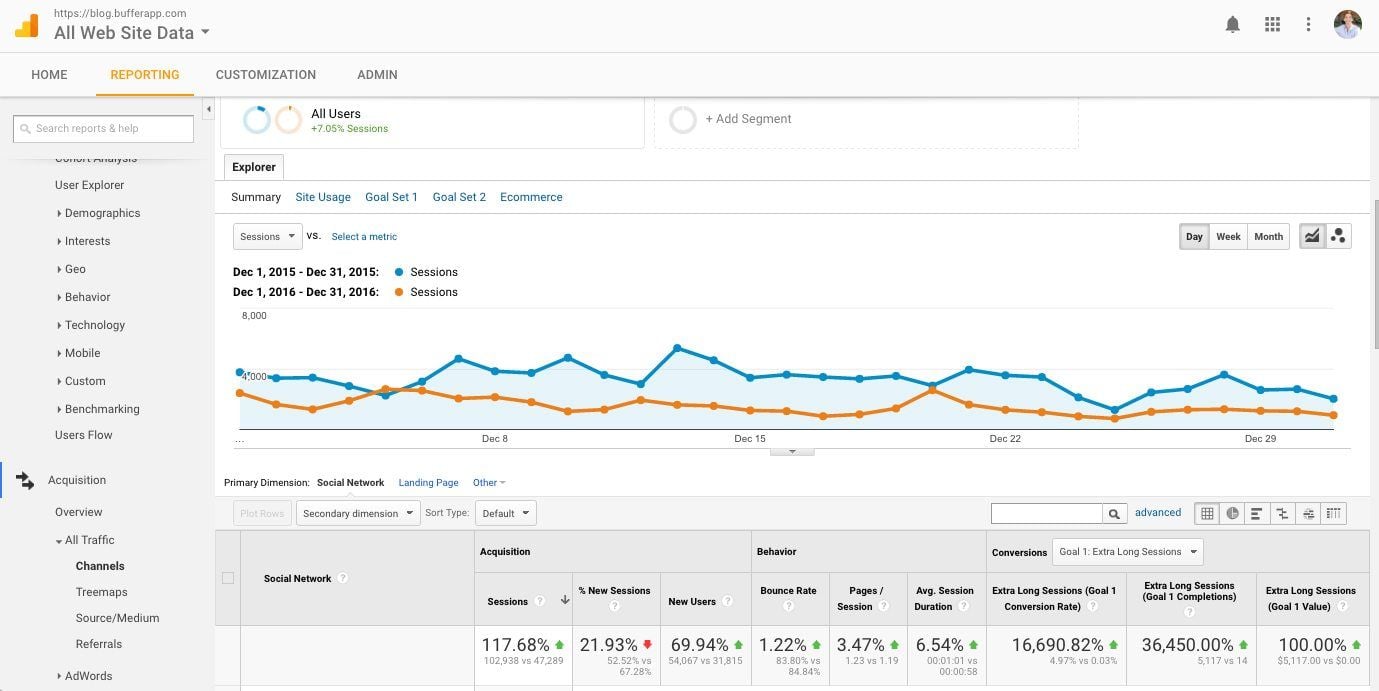
(Comparison of our social media traffic: Dec. 2015 vs. Dec. 2016)
Google Analytics is great for tracking big-picture data like overall sessions and traffic from around the web, whereas Looker allows us to get super granular with our data – diving deep into metrics like which blog posts are converting the most customers.
We keep a close eye on metrics like:
- Sessions (Goal of 4,000,000 sessions in Q1)
- New users (Goal of 950,000)
- Bounce rate (Goal of 83% or lower)
- Pages per session (Goal of 1.20 PPS)
- Avg. session duration (Goal of 1:00 min or higher)
Bounce rate and pages per session help us to get an idea of the overall quality of our content. We hypothesize that if users are sticking around and reading more articles on the blog then we’re on the right track with our content schedule.
It’s also important for us to use UTMs to track the effectiveness of individual campaigns so that we can measure the direct impact of the content that I put out vs. the impact of various other sources.
4. Establish Buffer as a social media thought-leader
An eye towards thought leadership and education is how we attempt to approach everything that we put out as a marketing team. It’s built into all that we do and so this could really be mixed in with all of our social media goals.
But it’s important to address these goals specifically as they play a big role in marketing and company growth.
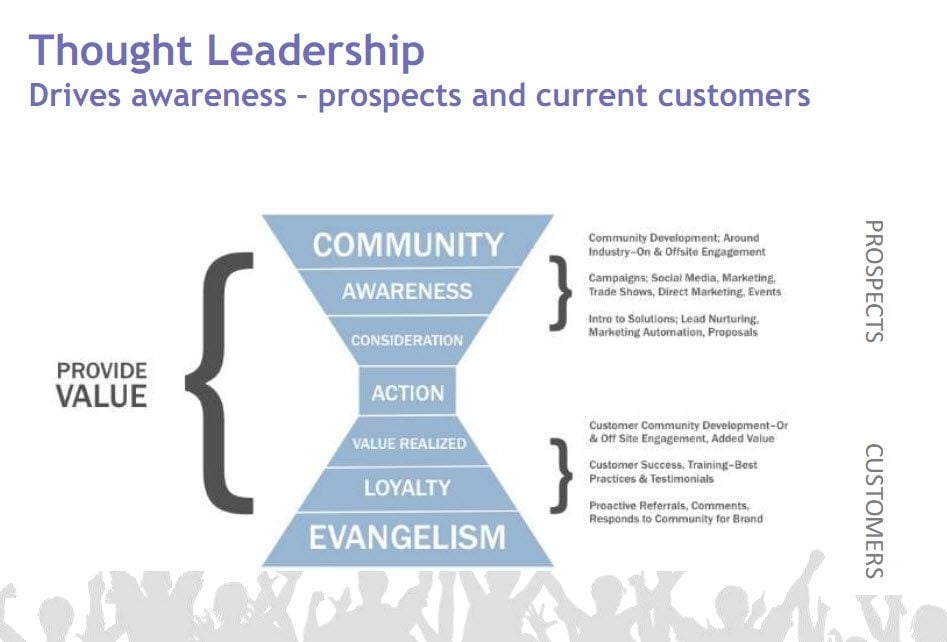
(“How to Measure Your Thought Leadership Program” – Marketo)
What is thought leadership?
I love Denise Brosseau’s definition of thought leadership:
“Thought leaders are the informed opinion leaders and the go-to people in their field of expertise. They are trusted sources who move and inspire people with innovative ideas; turn ideas into reality, and know and show how to replicate their success.”
The “know and show” part of Denise’s quote is what really gets me excited. There’s quite a difference between an article that talks about how to do something and an article that truly shows how to replicate success. Both can be very high-quality, but that really show readers value can be what begins to move influencers and brands into that thought leader realm.
How we measure thought leadership success
We measure thought leadership in direct relation to our content’s success. Metrics such as peer-recognition (mentions on social), PR coverage, podcast guests, SEO rankings, and direct feedback are all important.
For example, we’ve identified that when our content is picked up by various syndications, we see a direct increase in social media traffic to our blog resulting from the increase in shares. Hailley, our PR Crafter, has set the goal of increasing the number of articles that get picked up by 15% by working with our editorial team to ensure the content is shareable.
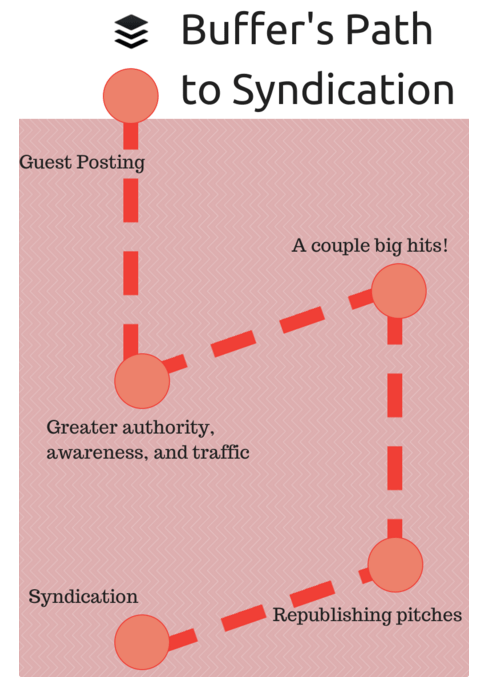
(A great article on syndicating content from Neil Patel shows what that might look like at Buffer)
Another thought leadership goal we’ve set for Q1 of 2017 is to reach an average of 7,500 downloads per episode on our brand new podcast – The Science of Social Media.
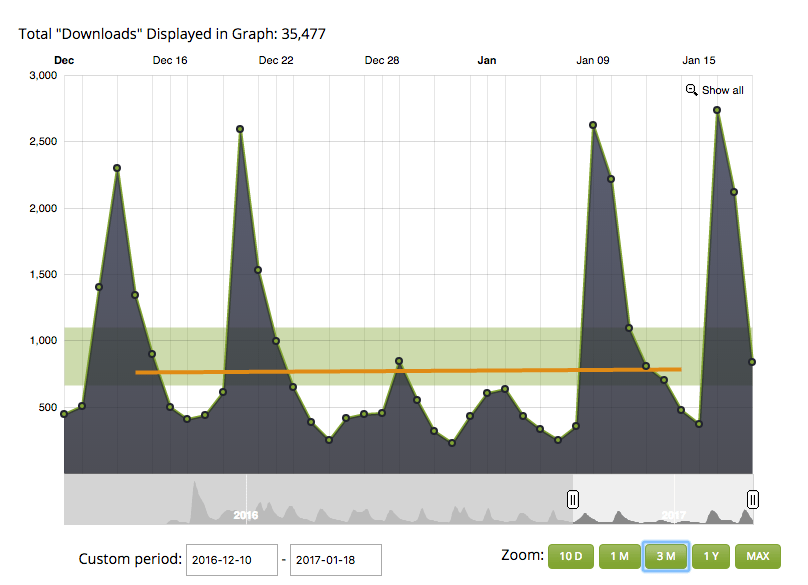
(The Science of Social Media daily downloads – Powered by Libsyn Podcast Hosting)
We’ve set a goal based strictly on downloads to ensure that we keep an eye on guest, sound, interview, information and education quality. 7,500 downloads per episode would put us on the top 10% of podcasts on iTunes – a wonderful sign of thought leadership and growth.
5. Create high-quality, industry leading content
Social media is an outlet that has the potential to have a huge impact on the spreading of ideas.
The Ice Bucket Challenge is a perfect example of that along with REI’s #OptOutside campaign (a campaign aimed to inspire people to choose the outdoors over Black Friday shopping) and countless others.
At Buffer, we love to create content thats helps spread our message, ideas and beliefs. The main goal if this is to build a community who are interested in what we’re doing.
Why an active social media community is important
There is a huge payoff to spending all of that time, effort, and money growing your audience and engagement on social media. The payoff is that you now have multiple platforms to tell the world about all of the cool things you’re working on.
For example, growing our audience on Instagram over the past year from 4,000 to 20,000 followers provides us with the opportunity to now share new features such as Buffer for Instagram with 16,000 (+350%) Instagram users.
Another great example is when we spend a few dollars on boosting our posts on Facebook. That money goes so much further than just extra post Reach. It brings people to our blog, drives extra Page Like, extra shares, extra comments, and so much more.
So that when we do have something important to share, there’s an audience there to listen, engage, share, and interact.
How we measure content quality
Audience size is one of the most essential factors when creating platforms to launch products and ideas and our hunch is that content quality is one of the biggest drivers of audience size.
I set an ambitious total audience goal along with individual goals for each social media platform based on previous data. Here’s what our audience growth goals look like this year:
- Reach a total audience size of 952,500 (10%)
Engagement rate is another metric that I love to track and one that is super important. Engagement rate gives us a good idea of what percentage of people find our content interesting and relevant.
Facebook and Instagram Stories are particularly interesting when it comes to tracking. Facebook makes it easy to track engagement within the Insights Tab under All Posts Published:
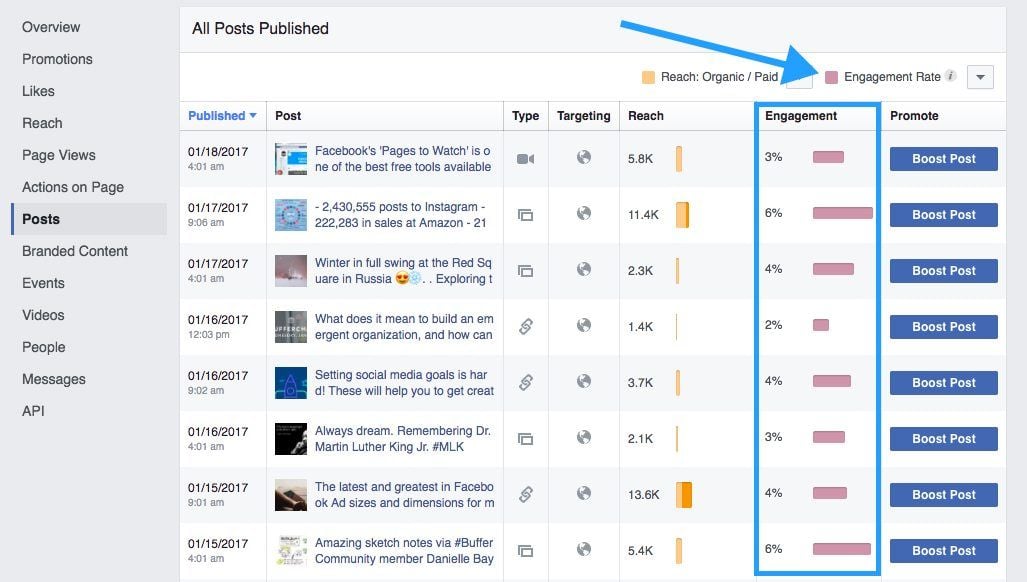
(A look at our All Posts Published ‘Engagement Rate’ under the Facebook Insights tab)
Our goal in Q1 of 2017 is to publish content on Facebook that receives a minimum of a 4% engagement rate. That will ensure that I am focusing on quality over quantity in a Facebook era of low organic reach and high competition.
Instagram Stories, on the other hand, is a bit different as all that’s available data-wise is how many people have viewed each Story and who.
(Total # of views in the first frame – Total # of views in the last frame / Total # of views in the last frame * 100 = Instagram Stories Engagement Rate)
Our goals for Instagram Stories in Q1:
- Run 8-10 Stories 3 times per week
- Grow our average number of first-frame views to 1,500
- Maintain a 55% engagement rate
- Average 5 direct messages after every Stories post.
Over to you
Thanks for joining me on this one! Here’s a quick review of our social media goals here at Buffer in Q1 of 2017:
- Grow brand awareness around Buffer
- Build Buffer’s community
- Drive traffic to our blog and generate leads
- Establish Buffer as a social media and marketing thought-leader
- Create high-quality, industry leading content
The key takeaway from all of this is that each of the social media goals that we create is: 1) based on previous data and learnings and 2) ambitious in nature. We even like to call them BHAGs (Big, harry, audacious, goals). We’ve also ensured that these goals are relevant to what we want to achieve as a company, not just a marketing team.
If you’re curious about how we came to these goals or would like to learn more about Objectives and Key Results (OKRs) – our goal-setting system inspired by the amazing folks at Google – feel free to drop me a comment below!
I would love to chat with you about your social media goals for 2017 and/or answer any questions you may have about our process.
Try Buffer for free
190,000+ creators, small businesses, and marketers use Buffer to grow their audiences every month.
